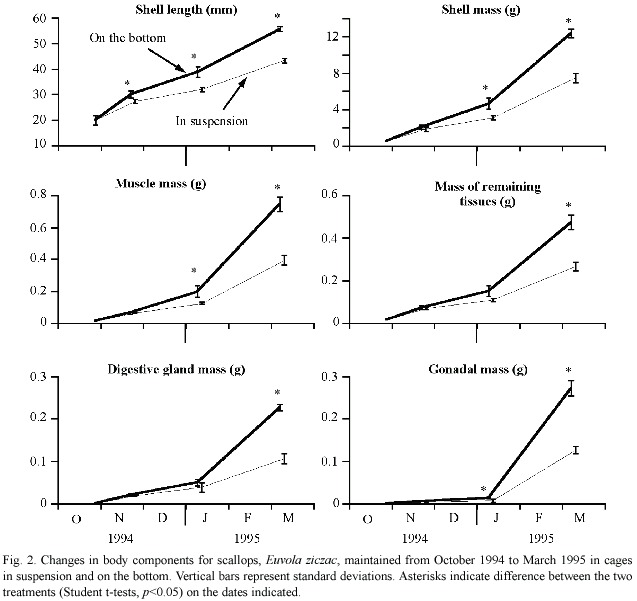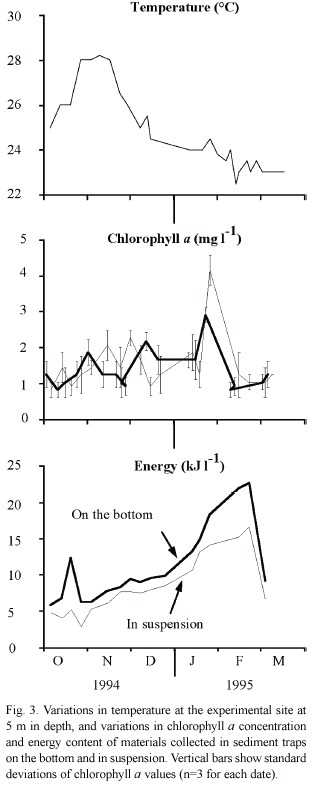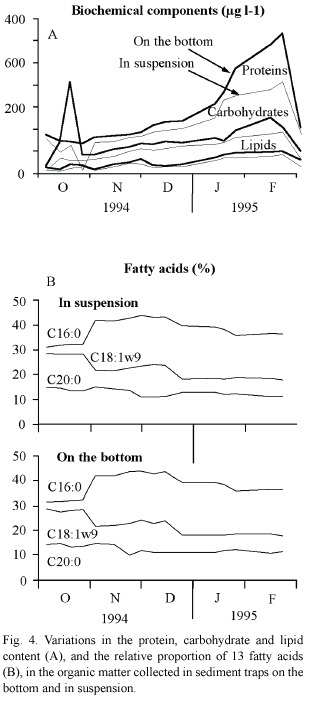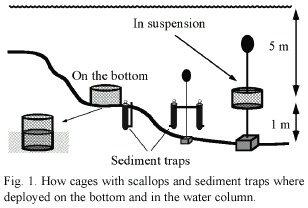Services on Demand
Journal
Article
Indicators
-
 Cited by SciELO
Cited by SciELO -
 Access statistics
Access statistics
Related links
-
 Similars in
SciELO
Similars in
SciELO  uBio
uBio
Share
Revista de Biología Tropical
On-line version ISSN 0034-7744Print version ISSN 0034-7744
Rev. biol. trop vol.53 n.3-4 San José Sep. 2005
Contribution of food availability to the more rapid growth of the scallop, Euvola ziczac (Pteroida, Pectinidae) in bottom than in suspended culture
Patrick Hunauld1, Anibal Vélez1, Noris Jordan2, John H. Himmelman3, Francisco Morales1, Luis Freites1 & César J. Lodeiros1
1 Instituto Oceanográfico de Venezuela, Universidad de Oriente, Cumaná, Venezuela
2 Dpto. Biología, Escuela de Ciencias, Universidad de Oriente, Cumaná, Venezuela
3 Département de Biologie, Université Laval, Québec, Canada G1K 7P4
Send correspondence to: César Lodeiros, Instituto Oceanográfico de Venezuela, Universidad de Oriente, Cumaná 6101, Venezuela, Phone/fax: 293-4302118; clodeiro@sucre.udo.edu.ve, cesarlodeirosseijo@yahoo.es
Received 06-VI-2005. Corrected 18-VII-2005. Accepted 10-VIII-2005.
Abstract: We conducted a 5-month experiment at Turpialito in the Golfo de Cariaco, Venezuela, to examine whether the previously reported more rapid growth of scallop Euvola ziczac in bottom compared to suspended culture can be attributed to more abundant or higher quality food resources near the sediment/water interface. The various body components (shell, muscle, digestive gland, gonad and remaining tissues) increased in size at a much greater rate for scallops maintained on the bottom, in partly buried cages at 5 m in depth, than in cages suspended at the same depth in the water column. Furthermore, survival was greater on the bottom. Food abundance and quality were examined by analyzing the seston collected in sediment traps at the sediment/water interface in the vicinity of the bottom cages and next to the suspended cages. Phytoplankton abundance (chlorophyll a) and the proportion of various fatty acids in the lipid fraction of the seston were similar on the bottom and in suspension. However, sestonic protein, lipid and carbohydrate levels, and the estimated energetic content of the seston, were higher on the bottom than in suspension, and probably contributed to the greater growth on the bottom. As the increase in the energetic content of the seston on the bottom compared to in suspension was less than the increase in growth (biomass) on the bottom compared to in suspension, and the evidence showed in previous studies above the negative influence of fouling and wave action in suspended culture, we conclude that the more rapid growth of Euvola ziczac in bottom than suspended culture is principally due to stress relative to suspended culture system. Rev. Biol. Trop. 53(3-4): 455-461. Epub 2005 Oct 3.
Key words: Scallop, Euvola ziczac, growth, suspended culture, bottom culture, Venezuela.
Vélez et al. (1995) showed that growth of the scallop Euvola (Pecten) ziczac (L.) in cages partly buried in a sediment bottom is markedly greater than in similar cages suspended in the water column. This observation is surprising, since numerous studies demonstrate increased growth of scallops when suspended in the water column (Leighton 1979, Wallace and Reinsness 1985, MacDonald and Thompson 1985a,b). Vélez et al. (1995) provide two hypothesis to explain this difference, (1) that E. ziczac grows better on the bottom because it is adapted to feeding on more abundant food resources at the sediment/water interface and (2) that maintaining the scallops in suspended culture causes a stress which decreases the energy available for growth. E. ziczac is a recessing scallop and in its normal habitat is usually buried with a thin layer of sand covering the slightly concave upper valve (Vélez et al. 1995).
In the present study we examine whether growth is increased in bottom culture because of more abundant or higher quality food resources available near the sediment/water interface. To evaluate this hypothesis we measured growth of scallops on the bottom and in suspended culture, and at the same time analyzed the abundance and quality of phytoplankton and organic matter available in the two culture situations.
Materials and methods
Our study was performed at Turpialito in the Golfo de Cariaco, northeastern Venezuela (10°2656 N ; 64°0200 W), and made use of 600 juvenile Euvola ziczac, measuring 18.5- 23.4 mm in length (mean length = 20.1 and mean dry tissue mass = 34.8 mg). The scallops originated from spawnings induced in the laboratory in July 1994. The larvae and post larvae were maintained under controlled conditions using the techniques described by Vélez and Freites (1993). The spat were maintained in pearl nets suspended at 20 m in depth from a long line until the beginning of the study. A sample of scallops was dissected to estimate the initial dry mass of the shell, muscle, digestive gland and remaining tissues (dried to a constant mass at 80°C). The remaining scallops were divided into two groups. One group was placed at a density of 12 scallops per cage in 24 cylindrical plastic cages, measuring 40 cm in diameter and 10 cm in height, and suspended at 5 m in depth and 1 m above the bottom (Fig. 1B). The scallops in the other group were maintained at the same density in 24 cages which measured the same diameter but 20 cm in height and which were sunk to a depth of 
We further evaluated the quality of the organic material in the traps by using liquid gas chromatography to determine the relative proportions of different fatty acids in the lipid fraction. We prepared methyl ester derivatives of the fatty acids following the technique described by Metcalfe and Schmitz (1961). The chromatography of methyl esters was carried out using a Varian model 3200 chromatograph equipped with a stainless steel column filled with 10% DEGS in Cromosorb 80-100 mesh. Nitrogen was used as the transporting gas at 38 ml min-1 and 180°C. The injector and detector were maintained at 235°C. The fatty acids were identified by comparison with commercial fatty acids purchased from Sigma Chemicals Ltd. and the percentages of different acids were quantified from the relative area of their peaks in relation to the total chromatographic area of the sample (calculated using a model 3390A Hewlett Packard integrator of area coupled to the chromatograph).
Results
Growth and survival in suspension and on the bottom: A difference between the two treatments (Student t-test, p < 0.05), in suspension and on the bottom, was detected for shell length on the first sampling date, 24 November 1994 (Fig. 2). On the second sampling date, 11 January 1995, a distinct difference (p < 0.05) was also apparent for the mass of the shell and muscle, and the mass of the remaining tissues tended to be greater for scallops on the bottom (p = 0.057). Growth rates increased between 11 January and 9 March 1995 and the increase was greatest for the scallops on the bottom. All somatic tissue parameters were markedly greater on the bottom than in suspension at the end of the study; the difference was by 28% for shell length and by 65 to 114% for the various mass parameters.

The scallops did not have gonads at the onset of the study and only had small gonads in November and January (Fig. 2). At the end of the study on 9 March 1995, all scallops had gonads and mean gonadal mass for the scallops on the bottom (0.27 g) was twice tham of the scallops in suspension (0.13 g).
For each of the sampling dates, survival was less for the scallops in suspension and the largest decrease in survival was after December. The cumulative survival during the study was 78.2% for the scallops on the bottom compared to 34.8% for those in suspended culture.
Relation of growth and survival to environmental factors: Temperature increased to a peak between late October and November (28-29°C) and then decreased gradually during the remainder of the study (Fig. 3A). The peak corresponded to a period of strong stratification of the water column and the decrease to the onset of upwelling conditions caused by sustained northwesterly winds (Okuda et al. 1978, 1981, Mandelli and Ferraz-Reyes 1982, Ferraz-Reyes 1987).

Phytoplankton abundance did not appear to be sufficiently different between the two sites to account for the differences in growth. Throughout most of the study, chlorophyll a values were similar in suspension and on the bottom (Fig. 3; Wilcoxon paired test, p=0.38). The values varied between 0.8 to 1.8 mg l-1, except on 25 January 1995 when there was a marked increase, particularly in suspension.
The determinations of protein, lipid and carbohydrate content of the organic matter collected in the sediment traps indicated that the food availability was greater on the bottom than in suspension (Fig. 4A, Wilcoxon paired test, p=0.003). The difference was particularly marked for the protein fraction. The difference between bottom and suspension was illustrated when we compared the energy content of particles on the bottom and in suspension (Fig. 3), based on the energetic equivalents provided by Gnaiger and Bitterlich (1984), 23.9, 17.5 and 39.5 KJ g-1, for protein, carbohydrate and lipid, respectively. The cumulative energy content based on the weekly sampling was 190 KJ l-1 on the bottom compared to 143 KJ l-1 in suspension. Both the biochemical fractions and estimated energetic content of the organic matter followed a similar changes over time, their being increases until late February and drops in early March. The analysis of the lipid fraction revealed the presence of 13 fatty acids (C10:0, C12:0, C14:0, C16:0, C16:1








Discussion
Our study corroborates the previous report of Vélez et al. (1995) that Euvola ziczac grows more rapidly when maintained in partly buried cages than in suspended culture. We further show that mortality rates are less on the bottom than in suspended culture. In our study, the only environmental variable identified which could account for the greater growth of scallops on the bottom was a greater availability of organic matter in the bottom seston. Protein, carbohydrate and lipid fractions for materials collected by the sediment traps were greater on the bottom than in suspension. The difference was greatest in the upwelling period, after mid-January. The similarity in chlorophyll a values collected by the traps on the bottom and in suspension suggests that living phytoplankton does not account for the differences in food abundance between the two habitats. Chlorophyll a values for water samples taken by Vélez et al. (1995) near the bottom and at the same depth further from shore also indicated that phytoplankton abundance in the water did not explain the greater growth on the bottom (values were least where growth rates were greatest).
Our study suggested effects of environmental factors on growth. The increase in growth rates from January to March coincided with the period of upwelling in the region and was likely associated with an increased availability of organic materials. Increased growth with increased food availability is reported for many species of scallops and other bivalves in temperate waters (Bernard 1983, Bayne and Newell 1983, Griffiths and Griffiths 1987, Bricelj and Shumway 1991, Thompson and MacDonald 1991). In contrast to temperate regions, the increased growth rates in our study coincided with decreased temperatures. The high temperatures attained during stratified periods may represent stressful conditions for E. ziczac (Lodeiros and Himmelman 1994, Boadas et al. 1997).
In our study, gonadal growth began in January in both bottom and suspended culture. At this time the scallops had attained a mean length of 39 mm on the bottom and of 32 mm in suspension. The sediment trap samples indicated that the subsequent rapid gonadal growth coincided with increased food availability.
Although we show that organic materials were more abundant near the sediment/water interface and could contribute to the accelerated growth of the scallops on the bottom compared to in suspension, other hypotheses must also be considered. Vélez et al. (1995) suggest that growth in suspended culture may be decreased because of stress caused by the inability of the scallops to bury themselves (as in their natural habitat) or by mechanical agitation caused by water turbulence. A negative affected of wave action on E. ziczac in suspended culture was subsequently demonstrated by Freites et al. (1999). An additional factor causing stress, or limiting access to food resources, for E. ziczac in suspended culture is the growth of fouling organisms on the scallop shells and enclosures (Lodeiros and Himmelman 1996, 2000, Lodeiros 2002). Whereas our study was not designed to evaluate the effect of fouling, we did observe marked differences in fouling between the two culture situations. At the end of our study the scallops in suspended culture were abundantly covered by tubicolous polychaetes and barnacles (especially along the outer edge of the shell) and also by a few oysters. Further, fouling organisms were abundant on the cages. In contrast, fouling organisms were nearly lacking on the scallops in the bottom cages, likely because they were buried most of the time, and the bottom cages were less fouled. We conclude that the more rapid growth of Euvola ziczac in bottom than suspended culture is principally due to stress relative to suspended culture system.
Acknowledgments
We are indebted to personnel at the Instituto Oceanográfico de Venezuela, Universidad de Oriente, particularly P. Nuñez and A. Sotillet, for help with the field work at Turpialito. The research was supported by grant of the Consejo Nacional de Investigaciones Científicas y Tecnológicas de Venezuela and Consejo de Investigación de la Universidad de Oriente.
References
Bayne, B.L. & R.C. Newell. 1983. Physiological energetics of marine molluscs, p. 407-515. In A.S.M. Saleuddin & K.M. Wilbur (eds.). The Mollusca. 4., Academy, NewYork, New York. [ Links ]
Bernard, F.R. 1983. Physiology and the mariculture of some northeastern Pacific bivalve molluscs. Can. Spec. Publ. Fish. Aquat. Sci. 63: 24 p. [ Links ]
Bligh, E.G. & W.J Dryer. 1959. A rapid method of total lipid extraction and purification. Can. J. Biochem. Physiol. 37: 911-917. [ Links ]
Boadas, M. A., O. Nusetti, F. Mundarain, C. Lodeiros, & H.E. Guderley. 1997. Seasonal variation in the properties of muscle mitochondria from the tropical scallop, Euvola (Pecten) ziczac. Mar. Biol. 128: 247-255. [ Links ]
Bricelj, V.M. & S. Shumway. 1991. Physiology: energy acquisition and utilization, p. 305-346. In S.E. Shumway (ed.). Scallops: Biology, Ecology and Aquaculture, Elservier/North Holland, NewYork, New York. [ Links ]
Emerson, C.M. 1991. A method for measurements of bed-load sediment transport and passive faunal transport on intertidal sandflats. Estuaries 14: 361-371. [ Links ]
Dubois, M., J. Gilles, J. Hamilton, P. Reber & F. Smith 1956. Colorimetric method for determination of sugars and related substances. Ann. Chem. 28: 2350-2356. [ Links ]
Ferraz-Reyes, E. 1987. Productividad primaria del Golfo de Cariaco. Boletín Instituto Oceanográfico Universidad de Oriente 26: 97-110. [ Links ]
Freites, L., J. Côté, J.H. Himmelman & C. Lodeiro. 1999. Effects of wave action on the growth and survival of scallops Euvola ziczac and Lyropecten nodosus in suspended culture. J. Exp. Mar. Biol. Ecol. 239: 47-59. [ Links ]
Griffiths, C.L. & R.J. Griffiths. 1987. Bivalvia, pp. 1- 88. In J.H. Pandian & F.J Vernberg (eds.). Animal Energetics, Volume 2. Academic, NewYork, New York. [ Links ]
Gnaiger, E. & G. Bitterlich 1984. Proximate biochemical composition and caloric content calculated from elemental CHN analysis: a stoichiometric concept. Oecologia 62: 289-298. [ Links ]
Leighton, D.L. 1979. Growth profile for the rock scallop Hinnites multirugosus held in several depths at La Jolla, California. Mar. Biol. 51: 229-232. [ Links ]
Lodeiros, C.J. & J.H. Himmelman. 1994. Relations among environmental conditions and growth in the tropical scallop Euvola (Pecten) ziczac (L.) in suspended culture in the Golfo de Cariaco, Venezuela. Aquaculture 119: 345-358. [ Links ]
Lodeiros, C.J. & J.H. Himmelman. 1996. Influence of fouling on the growth and survival of the tropical scallop, Euvola (Pecten) ziczac (L. 1758) in suspended culture. Aquaculture Res. 27: 749-756. [ Links ]
Lodeiros, C.J.M., Himmelman, J.H. 2000. Identification of factors affecting growth and survival of the tropical scallop Euvola (Pecten) ziczac in suspended culture in the Golfo de Cariaco, Venezuela 182: 91-114 [ Links ]
Lodeiros Seijo, C. 2002. Una cuestión de peso y de posición. Rev. Biol. Trop. 50(3/4): 875-878. [ Links ]
Lowry, D.H., N.J. Rosebrough, A.L. Farr & R.J. Randall. 1951. Protein measurement with folinphenol reagent. J. Biol. Chem. 19: 265-275. [ Links ]
MacDonald, B.A. & R.J. Thompson. 1985a. Influence of temperature and food availability on the ecological energetics of the giant scallop Placopecten magellanicus. I. Growth rates of shell and somatic tissue. Mar. Ecol. Prog. Ser. 25: 279-294. [ Links ]
MacDonald, B.A.& R.J. Thompson. 1985b. Influence of temperature and food availability on the ecological energetics of the giant scallop Placopecten magellanicus. II. Reproductive output and total production. Mar. Ecol. Prog. Ser. 25: 295-303. [ Links ]
Mandelli, E. & E. Ferraz-Reyes. 1982. Primary production and phytoplankton dynamics in a tropical inlet, Gulf of Cariaco, Venezuela. Int. Rev. Hydrobiol. 67: 85-95. [ Links ]
Metcalfe, L.D. & A.A. Schmitz. 1961. The rapid preparation of fatty acids esters for gas chromatographic analysis. Science 33: 363-364. [ Links ]
Okuda, T., J. Benitez-Alvarez, J. Bonilla & C. Cedeño. 1978. Caracteristicas hidrográficas del Golfo de Cariaco, Venezuela. Boletín Instituto Oceanográfico Universidad de Oriente 17: 69-88. [ Links ]
Okuda, T. 1981. Water exchange and the balance of phosphate in the Gulf of Cariaco, Venezuela. In F.A. Richard (ed.), Coastal Upwelling, Coastal and Estuarine Sci. 1: 274-281. [ Links ]
Pöhl, P. & F. Zurheide. 1979. Fatty acids and lipids of marine algae and the control of their biosynthesis by environmental factors, p. 473-523. In H.A. Hoppe, T. Levring & Y. Tanaka (eds.). Marine algae in pharmaceutical science. Walter de Gruyter, Berlin. [ Links ]
Strickland, J.D.H. & T.R. Parsons. 1972. A practical handbook of seawater analysis. Bull. Fish. Res. Bd. Canada No. 167: 310 p. [ Links ]
Thompson, R. J. & B.A. MacDonald. 1991. Physiological integrations and energy partitioning, p. 347-376. In S.E. Shumway (ed.). Scallops: Biology, Ecology and Aquaculture. Developments in Aquaculture and Fisheries Science Volume 21, Elsevier Science, The Hague, Holland. [ Links ]
Vélez, A. & L. Freites. 1993. Cultivo de "semillas" de la vieira Pecten ziczac bajo condiciones ambientales controladas. Memorias IV Congreso Ciencias del Mar, Serie Ocasional No. 2, Faculdad de Ciencias del Mar, Universidad Católica del Norte, Coquimbo, Chile, p. 311-317. [ Links ]
Vélez, A., L. Freites, J.H. Himmelman, W. Senior & N. Marín. 1995. Growth of the tropical scallop, Euvola (Pecten) ziczac, in bottom and suspended culture in the Golfo de Cariaco, Venezuela. Aquaculture 136: 257-276. [ Links ]
Wallace, J.C. & T.G. Reinsnes. 1985. The significance of various environmental parameters for growth of the Iceland scallop, Chlamys islandica (Pectinidae), in hanging culture. Aquaculture 44: 29-242. [ Links ]















